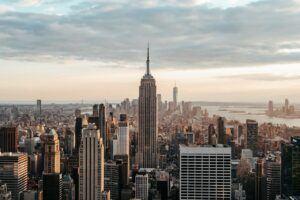Methodology America: Best Insurance Companies 2025

Forbes has been listing the best insurance firms in the country for the past five years.
These rankings—which were developed in collaboration with the market research firm Statista—come from a survey of over 18,000 Americans who said they had at least one insurance policy in any of the following five categories: renters, homeowners, auto, term life, or permanent life.
Similar to how we determined the list from the previous year, survey participants were asked if they were happy with their insurance provider and would suggest it to others.
In addition, participants evaluated their insurance companies based on aspects like pricing, customer service, transparency of the business, digital offerings, guidance agents provided, and claims handling.
Each insurance category’s ratings are added together to get a score, and the businesses with the highest scores are included in our rankings.
(The lengths of the lists differ for each type of insurance since the size of the insurance market, the number of evaluations received, and the final score all affect each list.)
As a result, our future list of America’s Best Insurance businesses 2025 will feature 97 insurance businesses that are ranked in at least one of the five insurance categories listed above.
On September 24, when the rankings will be revealed, check back.
Companies do not pay to be included or chosen, as is the case with all Forbes lists.
You can find out more about our employer lists and the process we use to compile this list here. To ask inquiries concerning this list, send an email to listdesk [@] forbes.com.
Observe me on LinkedIn or Twitter. Visit my webpage.
Give me a safe tip.
With the help of this three-phased scaling approach, renewable energy sources may be fully utilized to provide a dependable and resilient grid.
The core grid infrastructure must to be adaptable and dynamic, ready to incorporate new technologies and a variety of energy sources.
Three objectives should be the emphasis of owners and operators.
Enhanced control and visibility with cutting-edge grid technology.
In addition to preventing malfunctions and outages, smart meters, automatic control systems, and sophisticated monitoring tools offer real-time data on energy flow.
A utility firm in the United States installed sensors on two 230-kilovolt lines for less than $300,000.
This prevented the need for expensive reconductoring, which would have cost US$50 million, increased line capacity by around 18%, and decreased congestion charges from over US$60 million to US$1.6 million.
creating reliable energy storage systems. Improved energy storage reduces peak demand and intermittent renewable energy sources while increasing flexibility and dependability.
Examples of this include battery technology and hydro infrastructure.
bolstering the tangible infrastructure.

To reduce transmission loss, this involves hardening transformers, substations, and power cables. While high-efficiency transformers lower consumption, high-efficiency conductors can cut losses by 10% to 20%.
Phase two: Sparking decentralization linked to the grid
Energy networks that are decentralized, networked, and customer-focused are more durable and challenging to disrupt.
With the rise of rooftop solar panels, small wind turbines, distributed energy storage, and community energy initiatives, the paradigm is changing.
Next, techniques like dynamic pricing to lower peak demand and residential microgrids to regulate consumption can be used to encourage users to balance the grid.
By 2050, distributed resources in Australia might account for up to 45% of the country’s total electricity producing capacity.
Phase three: Establishing a networked energy environment
structures, as well as the infrastructure of smart cities, to improve energy management. Achieving this goal can involve:
employing smart industrial facilities and electric cars as clean power sources. Refeeding electricity into the grid through electric vehicles can increase grid stability.
According to studies, by 2030, vehicle-to-grid services might open up roughly 600 gigawatts of flexible capacity in countries like China, India, the US, and the EU.
leveraging the Internet of Things to create a smart urban fabric. Although sensors can help cut down on energy use, communities with a network of smart devices that use artificial intelligence to control production and consumption in both residential and commercial buildings may see greater benefits.
There are four prerequisites for grid upgrading.
The rate of modernization will depend on four interrelated factors: business strategies, talent accessibility, technology preparedness, and capital availability.
Money
It will be difficult to find the projected US$25 trillion in worldwide investment required to update the grid. Among the tools to make funding easier are:
attracting a wider range of investors to upgrading projects.
Increasing the amount of transmission revenue-backed securities and green securitization might make project cash flows tradable, lowering risk and improving liquidity.
Recovering costs more quickly.
Utility cost recovery might be accelerated by new rate case models that incorporate output-based incentives together with measures like price caps and performance benchmarks.
This would encourage efficiency and innovation.
Methodology America: Best Insurance Companies 2025

putting in place dynamic tariff arrangements. Tariffs may promote efficient use and bring in extra money by reflecting supply and demand in real time. Coneva, a
a scale-up from Germany that maximizes cost savings by combining local control with a dynamic power tariff.
Technology
Investment and modernization could both be accelerated by digital solutions.
Technology is essential to:
Increasing security: Threat intelligence can be shared between utilities, governmental organizations, and cybersecurity companies on a transparent, safe platform made possible by blockchain technology.
Value extraction from data: In order to give real-time insights for renewable energy integration and grid optimization, unified data platforms can combine and monetarily exploit grid data from smart meters, weather stations, and renewable energy assets.
Boosting compatibility: Common standards and open-source platforms encourage the use of renewable energy sources, such solar panels for homes.
Ability
The electricity sector is confronted with a shortage of 3.9 million workers and a skills gap due to rising competition, stagnant career advancement, and retirements. To
To.. Energy providers should start knowledge transfer and career development programs, such as peer-to-peer learning networks and modular training that provides micro-credentials for particular grid activities, to close these gaps.
Furthermore, grassroots training initiatives in grid monitoring at the local level can improve resilience and guarantee upkeep.
For instance, in Germany, cooperatives like the Bürgerenergiefonds enable public participation in and management of renewable energy projects.
Commercial frameworks
The necessary transition to consumer-centric, sustainable models is impeded by risk-averse mindsets, siloed organizational structures, and dynamic market conditions.
It is possible to bring about change by:
Methodology America

providing energy-as-a-service or utility-as-a-platform models.
Platform models provide peer-to-peer energy trading, demand response aggregation, and consumer energy management by utilizing a utility’s infrastructure. Likewise, clients could pay for energy or make use of micro-grids through a subscription model for energy services.
. while suppliers oversee investments in innovation and infrastructure upkeep.
utilizing dynamic pricing models to align contracts and rates. By offering competitive, transparent pricing, power companies create an energy marketplace that diversifies revenue streams and improves customer engagement.
Architects of change: Businesses, consumers, and policymakers all have separate but related responsibilities to play.
Complementary stakeholder effort is needed for a scalable and quick transition to grid modernization. The following should be prioritized:
encouraging the development of regulatory standards. This can entail setting up sandbox settings, like those in Singapore, where businesses test out novel energy-related goods and services.
In a similar vein, US Federal Energy Regulatory Commission Order No. 2222 promotes interconnection, variety, and efficiency among grid operators and consumers while permitting distributed energy resource integration in wholesale markets.
Fostering ecosystems that collaborate. Co-creation with utilities, research institutions, and startups such
since Energy Web’s platform for peer-to-peer energy trade can expedite cutting-edge technologies.
assisting with financing for the private sector.
Certain nations permit private investment in grid expansion with the aim of expediting the incorporation of renewable energy sources and circular practices.
incorporating distribution networks into cross-sector operations and bulk-system planning.
To maximize resource utilization and efficiency, coordination of waste management, water distribution, gas delivery, and electricity delivery must be done through a whole systems-based approach and closer integration of planning and operation.
Reaching the objectives of sustainable energy and grid stability may be facilitated by closing the investment and development gap, integrating cutting-edge technology, and decentralizing energy sources.
A phased strategy and a focus on stakeholder collaboration could hasten the energy transition and pave the way for a sustainable, net-zero energy environment.
READ MORE:
1. Health and Fitness Tips for You
2. Upcoming New Movies
3. Get New Jobs Directly From Companies FREE Visa
4.Latest News of Cryptocurrency and Bitcoin
5. Real Estate Business for you
6. Latest News
7. Best Insurance Policy for Everyone
READ MORE:
- 1. Strategic Management Process: Top5 Jobs In Dubai FREE VISA Apply Now
- 2. Vancouver Time fighting for $12,000 in travel insurance Nightmare FREE
- 3. DIABETIC DIET : A PROFESSIONAL’S GUIDE TO A WARM AND WELL-BEING
- 4. NICOLAS CAGE STATES : HE HAS 3 OR 4 MORE MOVIES LEFT NOW
- 5. EMPRESS CRACKS: FOR THE FIRST TIME SINCE APRIL
- 6. DESPITE MEANING: DESPITE HIGH RATES, MORE US HOME BUYERS ARE WILLING TO BUY
- 7. A 44-YEAR-OLD BOSTON WOMAN WAS KILLED BY A SHARK ATTACK IN THE BAHAMAS WHILE ON VACATION







